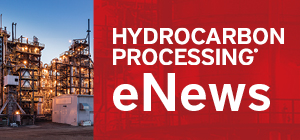Hydrotreating
A multi-objective optimization study for an integrated oil refinery-petrochemical plant—Part 2
In this research, the integration of an oil refinery and an ethylene-producing facility was examined using a mixed-integer nonlinear programming model that prioritized maximizing ethylene and propylene production and net profit.
Why poultry fat is emerging as a solution for the renewable energy industry’s increasing need for diverse biofuel feedstocks
Throughout the past decade, biofuels production has significantly increased. Some of the largest growth in the sector has been with fuels that rely on lipids, such as vegetable oils and animal fats, as feedstock. This includes biodiesel, renewable diesel and sustainable aviation fuel (SAF).
New generation slurry reactor for the hydrotreatment of heavy oils and distillates
Due to the ongoing transition to a low-carbon energy system, refiners must produce less fuel oil. Among the technologies used for the commercial-scale hydroconversion of the heavy fraction of crude oil, the use of bubble column upflow reactors with slurry catalyst (slurry technology) does not produce fuel oil.
How to gain an advantage from the propylene production gap—Part 2
This work will detail the available processing routes capable of maximizing propylene yield in refineries, allowing refiners to gain advantage from the propylene market.
Implement innovative corrosion management solutions for biofuel refining—Part 2
The production of carbon-neutral and renewable transportation fuels is growing rapidly, driven by the need to find feedstocks beyond fossil resources. Environmental, social and governance (ESG) initiatives—along with accelerated consumer demand for sustainable and carbon-negative fuel products—are also driving demand.
Advanced hydrocracking unit flow scheme optimization and integration approach to maximize refinery margins for a residue upgrading project
The integration of a solvent deasphalting and hydrocracking upgrading complex provides a favorable techno-economic return for residue upgradation at relatively lower capital expenditures vs. other alternatives for a brownfield project.
Refineries’ pandemic turmoil—KNPC’s gasoline demand: Opportunities and challenges
The COVID-19 pandemic is regarded as one of the most exceedingly difficult challenges faced in the oil and gas industry's history.
Implement innovative corrosion management solutions for biofuel refining—Part 1
The production of carbon-neutral and renewable transportation fuels is growing rapidly, driven by the need to find feedstocks beyond fossil resources.
Digital Exclusive: Refineries’ pandemic turmoil—KNPC’s gasoline demand: Opportunities and challenges
In this exclusive digital article, KNPC provides a comprehensive analysis of the difficulties and challenges that the company experienced during the COVID-19 epidemic and how its refineries adapted during this challenging time.
FCC and HDS feed flexibility and integration with the delayed coker in the Izmit refinery
Operational flexibility is one of the key parameters that leads to success and sustainability in refinery production.

- Petrobras wrapping up due diligence to buy back refinery from Mubadala 7/26
- US court rejects EPA denials of 2022 small refinery biofuel waivers 7/26
- Mexico seeks more 2025 fuel import deals after refinery delays 7/26
- PETRONAS, Eni and Euglena reach FID to construct a biorefinery in Malaysia 7/26
- ExxonMobil signs carbon capture agreement with CF Industries in Mississippi (U.S,) 7/26
- WoodMac: LNG truck sales impacting Chinese road diesel demand 7/26
- Digital Exclusive: SPECIAL FOCUS: Digital Technologies—Utilize process simulation digital twin to optimize condensate yield
- Digital Exclusive-Flare system design: Liquid pockets in flare headers
- Hydrogen-rich content gasoline: A new concept for paraffinic gasoline reformulation
- Alarm rationalization at Kuwait National Petroleum Company (KNPC) refineries




